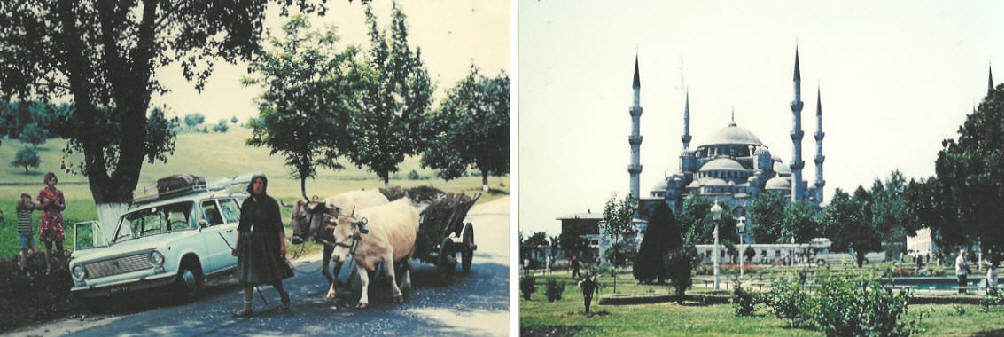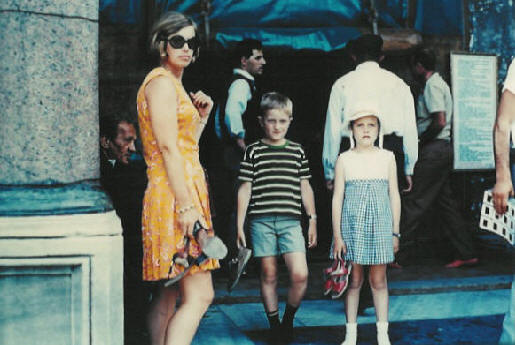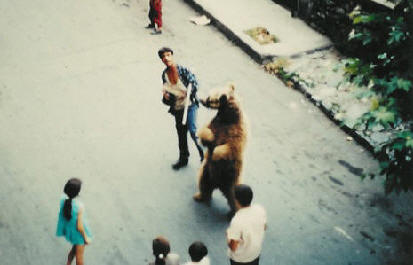
Greece, Turkey(1969)
To Greece and Turkey in our Station Wagon One sunny August day in 1969, Jill, Rob, Val and I loaded up our little, blue Fiat station wagon, backed down the driveway from our villa on the Italian Riviera, dropped Marnie off with our friends, Tom and Sue Lowenberg, . . . and drove to Istanbul.
 |
On the Road . . to Istanbul
The first leg of the trip . . . the two thousand kilometers from Arenzano to Istanbul . .. involved the most concentrated driving . . . but we found the roads surprisingly good so that, all-in-all, it was a very easy and pleasant drive. It’s not that the roads in Eastern Europe are super-highways . . . but that in Yugoslavia and Bulgaria there are relatively few cars so that it’s open road all the way.
Our overnight stops were in Belgrade and Sofia (the capital cities of Yugoslavia and Bulgaria respectively). Although we didn’t find Belgrade particularly impressive, we were quite impressed with the beauty and graciousness of Sofia . . . nice parks, many trees, wide avenues, etc. Our time being short we hired a guide, who drove around the city with us in our car and pointed out things of interest. He was a young man entering the University in the fall, and although the tour was heavy on monuments to "Communist brotherhood", we found him personally to be quite friendly and open in our conversations about the comparative life in Bulgaria, Italy and the U.S. I was interested to hear that he had followed the flight of Apollo 10 closely on television.
The Balkan countryside is green and rolling and apparently quite fertile. Farming methods, however, aren’t advanced . . . with horse-pulled plows and scythe-harvested grain the rule rather than the exception. Most of the people in the country still wear the typical peasant dress . . . with the women especially very colorful with many-colored skirtss and aprons and white babushkas.
Istanbul. The first sight of the city . . . its skyline studded with the mosques and minaret towers . . . is in itself enough to justify the trip. What a city!!. We found ourselves a stately old hotel with a room overlooking the comings and going on the Bosporus. One of the first sights from our hotel room window was a man and his dancing bear right below our window much to Jill and Rob’s excitement and delight.
 |
 |
Entering the Blue Mosque Dancing Bear Outside Our Window
Later in the day we took a Cook’s tour to get oriented a bit . . . then went back to go through some of the mosques and bazaars on our own. In think the kids were especially impressed by their first visit inside a mosque . . . first because they had to take their shoes off and second, because they had never before seen people worshipping prostrated on prayer carpets, Moslem-style. Unfortunately, they’ve abandoned the traditional call to prayer from the top of the minarets and now use a loud-speaker system. We were relieved to note, though that at least the call over the loud-speaker was made by a flesh-and-blood person and was not a recorded message.
We took the ferryboat over to the Asian side of Istanbul the next day. Istanbul is, unique in that it straddles two continents with half the population living in Asia and the other half in Europe. So Jill and Rob can now say that, as a result of this itinerant life of ours, they’ve found them selves in four different continents over the past twelve month. It’s just an hour’s drive from Istanbul up to the Black Sea . . . so we went up one morning for a swim. Magnificent sandy beach . . . and we thoroughly enjoyed the swim. In fact, although it may seem like a busman’s holiday from the Riviera, we stopped every chance we had throughout the trip for swims and really found some great spots . . . especially along the Greek coast on the Aegean Sea.
Athens and the Greek Islands. The highlights of the drive from Istanbul to Athens were probably Thermopylae and Delphi. At Thermopylae there is nothing but a statue and a memorial plaque where the Spartan king Leonadis and his small army died trying to set up a first line of defense against the onslaught of the Persian armies. The coast has long since changed its geography due to silting so it’s difficult to envision that it was once a narrow pass where two soldiers abreast could block an army of two million men . . . but nevertheless one feels a strong sense of history standing at that spot.
 |
Jill and Rob at the Pass at Thermopylae Temple of Minerva at Delphi
Delphi, too, is impressive from the sense of history which it conveys . . . but also from the magnificence of the ruins (The temple of Apollo, the theater, the stadium, etc.) and its dramatic setting looking down into the deep, rugged valley up which the petitioners had to come to see the Oracle.
In Athens we took a hotel at the foot of the Acropolis (in the old market area called the Plaka) so that we were just a fifteen minute climb up the hill to the Parthenon. In fact, the hotel had a roof-garden where breakfast we served every morning with the awesome Acropolis for our backdrop . . . a great way to start the day. There isn’t much I can add her about the Acropolis which you don’t already know. We went up the first night on our own, the first night in the light of the full moon. . .a glorious way to be introduced. (We missed the "Sound and Light" performances, in fact, since they are not held when the moon is full.)
 |
Parthenon Mykonos
Frankly, though, beyond the Acropolis (and the Archeological Museum) there is really little else of touristic interest in Athens itself . . . so on our third day there we went down to Piraeus (Athens’ seaport) and took a two day cruise to some nearby Greek islands in the Aegean. Mykonos was our overnight stop off . . . the kids of place you "discover" and never want to leave. What a charming place . . . all the houses, shops, walls and even sidewalks are whitewashed a sparking white. Not having hotel reservations, we put up in the house of one of the villagers. It’s the practice there due to lack of commercial accommodations . . . but very satisfactory and inexpensive. The island is covered with windmills and we found a friendly miller, who consented to take the kids up the ladder to the mill room, where they saw how grain is milled into flour.
Peloponnesos. From Athens we shifted base to Nafplion, a seaside resort in the eastern Peloponnesos . . . and from there we went only short drives from Corinth, Mycenae, Tirins and Epidaurus. Mycenae is, of course, impressive since that civilization pre-dates the "ancient’ Greeks by over 1000 years . . . yet the palace and ruins are still very much in evidence . . . and the story of King Agememnon’s murder by his wife, Clytemnestra all seems quite real and vivid.
But, even more exciting was Epidaurus, where we saw Sophocles’ "Antigone" presented in a Fifth Century B.C. theater carved into a wooded hillside and still perfectly intact from twenty-five centuries ago. Despite the fact that Epidaurus is pretty far off the beaten path, there were over 1,000 people there for the performance.
 |
The Lion's Gate at Mycenae The Original Olympic Torch
From Nafplion, we drove across Pelopennese to Patras, where the car ferry embarks for the trip back to Italy. Enroute we stopped at Olympia long enough to wander around the site of the first Olympic games. The temples have been destroyed but the original stadium is still there as is the fount for the Olympic flame. (It is not an eternal flame but is rekindled every four years using the rays of the sun).
The cruise up the Adriatic was great . . . two nights and one day (Jill and Rob spent the whole day in the swimming pool) . . . very restful . . . and we were home by mid-afternoon Wednesday . . . relaxed and ready to head off somewhere else.